Protecting the nations’ water supply
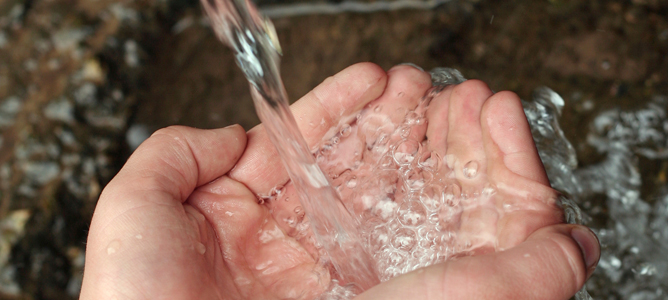
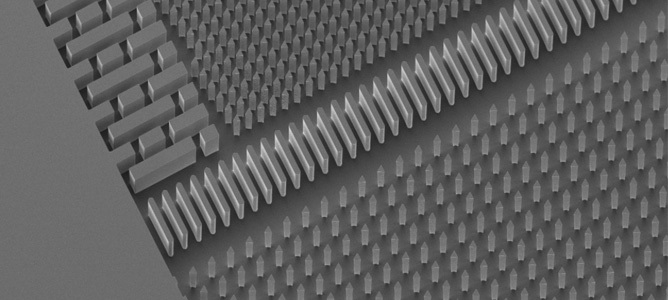
Nanostructural features present on a microfluidic wafer.
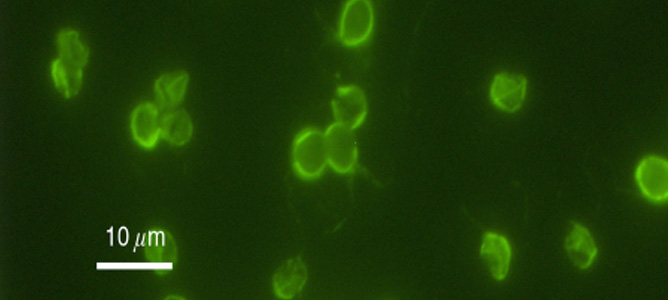
Cryptosporidium Parvum Bacterium
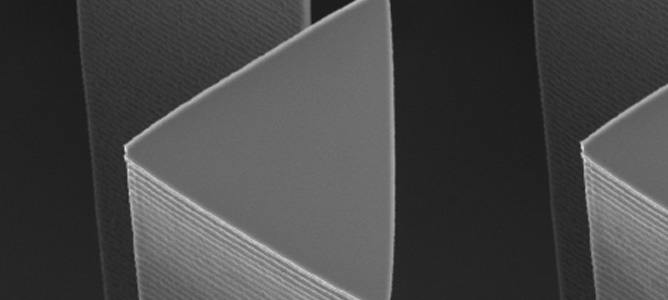
Close up of nanostructural features present on a microfluidic wafer.
March 2012
Microfluidic sensing platforms capable of sorting and filtering nanoparticles within aquatic sensor systems may hold the key for future pathogen detection within community water supplies.
Using a fluid separation element fabricated within MCN’s state-of-art photolithography and clean room facility, this device harnesses the process of surface acoustic waves to actively filter harmful disease-causing pathogens. Such pathogens include the Cryptosporidium Parvum Bacterium, responsible for the 1998 Sydney water crisis.
Given the expertise and unique array of equipment available with the MCN, the facility has allowed the technology to be completely transposed from design to development within a single place. Hosted by MCN, this work forms part of a cluster collaboration between CSIRO and Australian universities to create an integrated device which may one day filter our nation’s water supply.
Safer surgeries with microbots
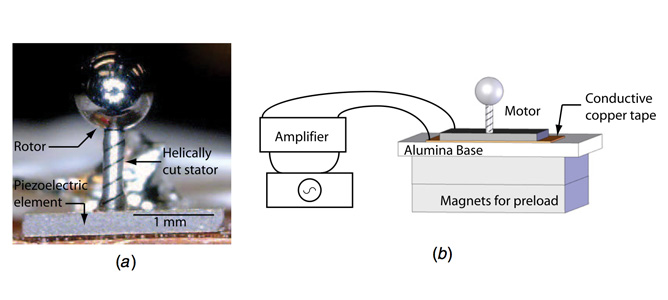
a) Photo of the micro-motor prototype showing the helically cut stainless steel ball as a rotor and the PZT element. b) Magnets were used to increase the friction coupling preload
March 2012
The future is here - microrobots are making minimally invasive vascular surgery safer and more efficient.
Researchers at MCN have developed a 240μm-diameter ultrasonic micromotor capable of navigating through arteries deep inside the human body. The technology, developed by Professor James Friend of RMIT University, is designed to assist surgeons whilst performing minimally invasive vascular surgery (MIVS).
The ultrasonic micromotor comprises a 50μm-diameter stainless steel ball rotor mounted on a laser machined precision tube, prepared at the ANFF OptoFab node. The stainless steel ball is held in place using a magnetic payload generated from a permanent magnet, allowing it to make contact with the inner diameter of the tube. According to Professor Friend, the micro-sized motor generates rotational motion from a combination of orthogonal and longitudinal vibration modes. The drive’s input signals are provided via two 50μm diameter wires. The micromotor assembly is designed to be affixed to standard catheter tips, providing smooth navigation through vascular pathways.
This technology has several advantages over existing MIVS techniques that traditionally have a failure rate of up to 40%. The first major advantage is that the catheter guide wire is actively navigated using a motor, rather than being forcibly pushed through arterial passages. This is likely to result in a reduction in injury to vascular membranes. Further, complex cerebral events (such as an aneurism) have a time-sensitive treatment window. This technology allows medical specialists to locate and treat the cerebral event up to 20% faster than conventional MIVS procedures.
In addition, Professor Friend notes that modelling shows that up to 85% of 350μm cerebral arteries can be accessed easily with this novel micromotor because its tip size is less than 250μm. Combined with an additional 4 cm of reach, this technology provides opportunities for treatment well outside the scope previously available.
A simulated video can be viewed here.
Industry R&D looks at water source analysis
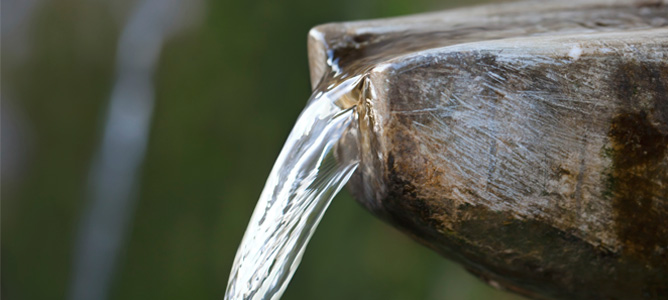
March 2012
MCN has become a regular feature of the Small Technologies Industry Uptake Program (STIUP), having been part of seven successful applications totaling a combined value of approximately $750,000. The Victorian government-funded STIUP initiative assists Victoria’s innovative small technology companies with the cost of access, consultation and R&D services provided by state-of-the-art facilities such as the MCN. The latest entry into STIUP is Aqua Diagnostic; a Melbourne-based water management company. Aqua Diagnostic fabricate chemical oxygen demand sensors, PeCOD® which provide reliable analysis of water sources. Their flagship PeCOD® sensors assess water quality by detecting organic compounds, such as pollutants in surface water.
Aqua Diagnostic is looking to develop and implement an automated sensor production process, capable of producing PeCOD® sensors in commercial volumes at high quality. To do this, they must first identify the critical specifications required during the manufacturing process of the PeCOD® sensors.
By using specialised services and established equipment, MCN will investigate the key characteristics such as crystalinity, particle size, surface area, porosity, thickness and surface chemistry of the PeCOD® sensors. Assessing the characteristics of effective sensors will provide insight into the failure mechanisms and causes of performance reduction of the devices in service. This knowledge will then be integrated into both the optimisation of the manufacturing process and the fundamental understanding of the sensor operation.
This will then inform the implemention of a cost-effective characterisation system for ongoing quality control within the manufacturing process.
MCN has supported companies such as Grey Innovation, Biodetectors Ltd, and Liquitab, by improving on existing designs, providing consultation services for novel ideas, and determining the feasibility of new projects.
Automated systems for cell transfection
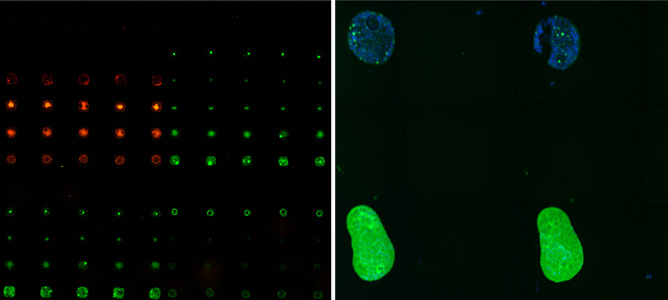
(a) Image of RTCM created using the Nanoprint MicroArray System located at MCN. (b) Close-up of Array Spots. Protein vectors are tagged with GFP and appear green. HeLa Cell Nuclei are labelled with DAPI and appear blue. DNA is cy3 labelled and appears red.
March 2012
Research areas that involve time consuming and repetitive processes may benefit by adopting new experimentation methods, which involve efficient screening. Incorporating nanosystems into these experiments can also provide useful insight into the interaction of nanomaterials within the biological environment, gene expression, targeted cell delivery and encapsulation.
Michael Nastasie, a researcher from Monash University is working in collaboration with MCN’s Varsha Lal to design a novel process capable of conducting a series of simultaneous nano-experiments within an automated array system. This will allow them to observe the transfection of numerous known DNA constructs into specific mammalian cell populations.
Transfection is the process of deliberately introducing nucleic acids into cells. Using the MCN’s MicroArray system, the team can perform transfection experiments simultaneously using the high throughput capabilities of the microarray system. According to Michael, “the microarray system available at the MCN will be crucial in the ability to simultaneously test numerous different transfection solutions, on a large variety of surfaces, under controlled humidified conditions, with minimal user interaction.” Since an array can contain tens of thousands of probes, the automation and concurrent nature accomplished by this MicroArray system drastically improves the efficiency of experimentation and accuracy of results and gives researchers the power to test large quantities of cells in concurrent experiments.
Synthesising high quality enzymes
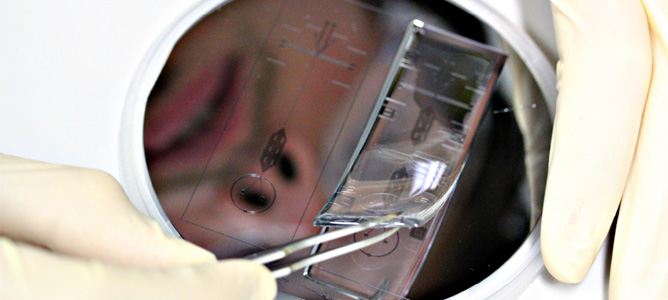
Microfluidic device designs for the production of high quality enzymes
March 2012
Enzymes, organic catalysts capable of facilitating physicochemical and biological reactions, have captured the attention of industry and the scientific community alike. In nature, enzymes are used to catalyse and break down proteins. New methods of synthetic production have vastly broadened the applications of such enzymes to include food processing, textile and paper production, biological detergents and farming, medical and therapeutic processes, fuel production and sustainability practices.
According to Florian Lapierre from CSIRO, one of the major challenges of synthetic enzyme production lies not in the overall yield size, but achieving a product that is of consistently high quality. Using the soft lithography capabilities within the MCN’s cleanroom facility, a micro droplet sorting device has been fabricated and is currently undergoing extensive testing. The prototype is capable of generating amino acid emulsions, synthesising proteins via electrically induced coalescence, detection and subsequent sorting of high quality enzymes. The result is a purified sample, which can then be used for catalytic processes or stored for later use.
Identifying key materials for chemical sensors
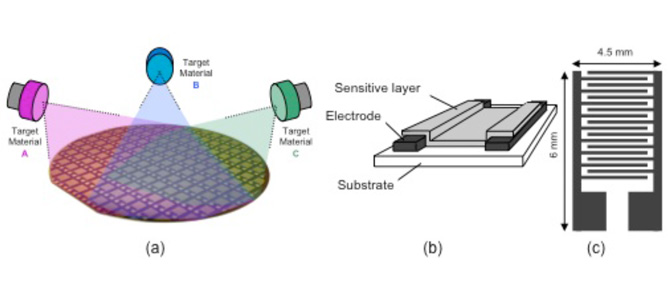
(a) Set-up for combinatorial sputter approach of metal oxide thin films, (b, c) cross- sectional view of the fabricated sensors.
February 2012
This project looks at the creaton of a rapid, convenient, and effective solution for discovering multicompositional materials with the best performance from a large compositional landscape.
To achieve this, MCN’s Dr. Sasi Kandasamy collaborated with Dr. Adrian Trinchi and Dr. Tim Muster from the Centre for Materials Science and Engineering and CSIRO.
In designing chemical sensors, combinatorial approaches facilitate with relative ease the discovery of new material compositions with optimised chemical sensing properties, particularly when combined with high-throughput analysis. This in turn allows for libraries of materials that have high sensitivity and selectivity towards specific analyte chemical species to be established.
In this collaborative initiative, the project uses an array of approximately 12 x 12 sensors, fabricated on a 4-inch silicon wafer and tested for their hydrogen gas sensing characteristics using high-throughput impedance spectroscopy. Metal oxide thin films with different compositions of titanium, tungsten and molybdenum were deposited using reactive sputtering at different sites on a single substrate by using masks to define the film deposition sites. The different signal fingerprints of the sensors with different concentrations of these elements successfully demonstrates the validity of these combinatorial chemical sensor design.
50nm biosensors to detect antigens
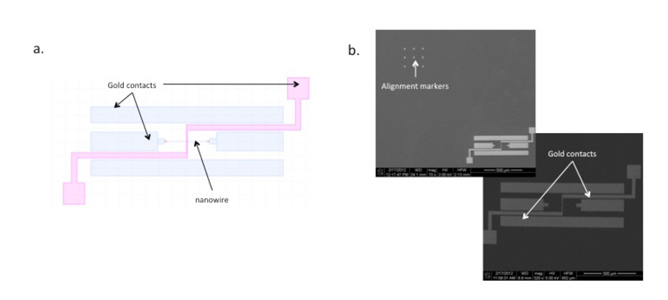
a) CAD file outlining the position of the alignment markers with respect to the single device; b) SEM images of the device with markers, and a close up on the device;
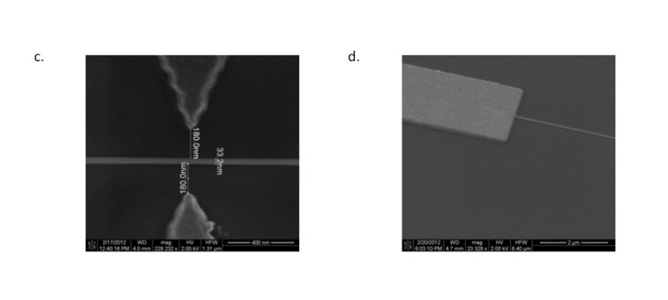
c) SEM image of the nanowire, less then 35nm wide, placed in between the electrodes very accurately. d) SEM image of the device dry-etched to the desired depth.
February 2012
This project aims to develop a set of processes to fabricate a biological nano-sensor which is sensitive to a specific type of biological antigen. To achieve this, MCN’s Dr. Matteo Altissimo and Thanh Nguyen from the University of Melbourne fabricated a set of gold contacts and gold alignment markers on a silicon wafer by means of Electron Beam Lithography (EBL), metal deposition and lift-off. A nanowire was then overlayed on existing gold contacts using the automatic alignment routines of the Vistec EBPG5000plus EBL tool. The negative resist used in this step was then used as a mask for dry etching of the underlying silicon, to a depth of 50nm.
The nanowire surface was then be functionalised by specific antibodies, which selectively bound to their complementary antigens. The binding of antigens could then be detected using electrical measurements.
Interestingly, the EBL tool used only four markers to align all of the exposed nanowires. Despite the fact that the markers were on average more than 20mm away from the target position of the nanowire, the accuracy of the overlay is better than 10nm. This is equivalent to hitting a target 20 km away within an accuracy of 10mm, after measuring the position of 4 template markers.
Predicting artery plaque rupture
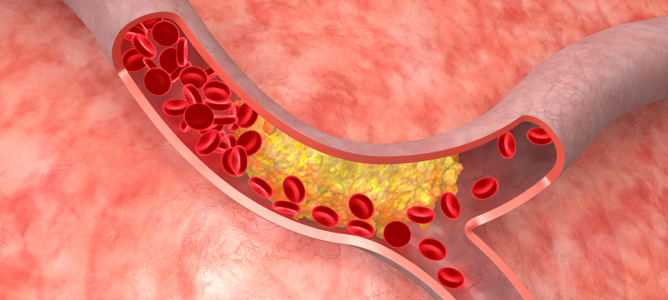
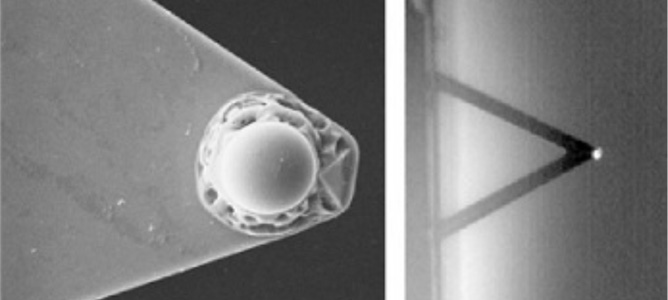
Sphere (left) attached to the cantilever tip (right).
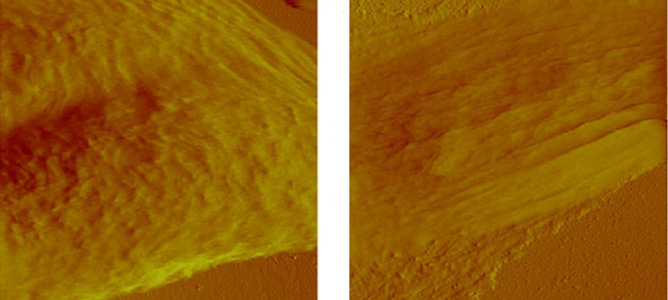
AFM deflection image of cancerous (left) and benign breast cells (right).
February 2012
Due to lipid build up in artery walls, plaques form that can rupture and cause significant health problems for patients. Researchers at the Baker institute have worked together with MCN to study and predict the likelihood of plaque formation and rupture due to Atherosclerosis in an attempt to prevent it.
Atherosclerosis occurs when lipid steaks infiltrate and build-up in the artery walls, creating a plaque as a result. These plaques can be divided in two distinct types: those that rupture (vulnerable) and those that are less likely to rupture (stable).
In this project, the Nanowizard II AFM was used to determine the elastic properties of the vessels and plaque as well as the topography of the plaque surface. The first results were directly implemented in computational fluid dynamics software. Studying the surface topography then led to the development of models for the boundary conditions along the artery walls. This work will employ a new model in mice, to be used for predicting the formation and properties of vulnerable plaques.
A difficulty in the present approach is working with wet and soft samples. In particular, working with soft samples implies a specific set up for modified cantilevers, in which a sphere is bound to the AFM cantilever (see image above). Tests will be conducted using breast cancer cells to improve this methodology and optimise the conditions for cantilevers. Cantilever optimisation experiments will utilise the cleanroom facility at MCN.
Liquitab, not a hard pill to swallow
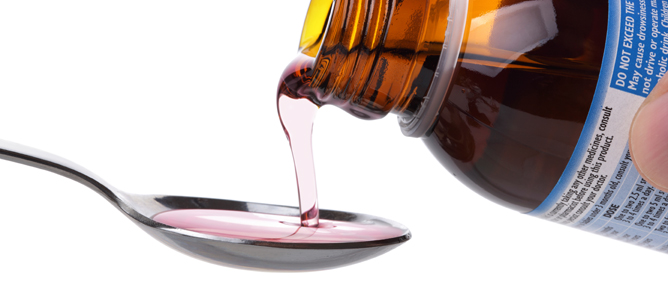
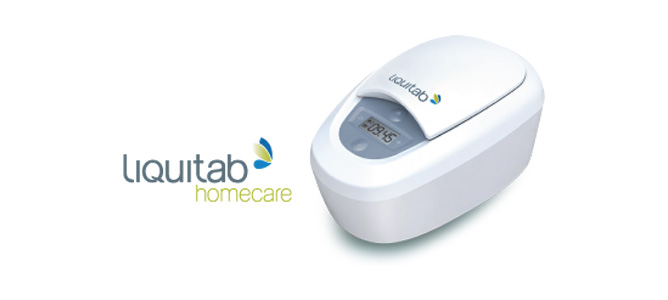
The liquitab will potentially assist millions in taking their daily medications.
February 2012
The days of taking costly liquid antibiotics will soon be over for people suffering dysphagia - discomfort when swallowing pills. Liquitab Systems Ltd. has engaged with MCN to develop a unique technology, capable of grinding pills into a palatable liquid
Utilising facilities at MCN, Liquitab have developed a unique technology capable of crushing and grinding commercially pressed-pill medications into a palatable liquid. The technology harnesses high frequency ultrasonic vibrations to grind pressed-pill medicines and is aimed at assisting those who have difficulty swallowing conventional tablets.
The Liquitab tablet-crushing technology involves the deformation of a metal ring embedded with a removable non-reactive cup. The pressed pill is placed into the cup and ground using the resonant frequency omitted by a transducer. The result is a powdered medication that can be mixed with water to assist with administration.
Professor James Friend applied his expertise and knowledge of ultrasonics to enhance performance of the device. According to Professor Friend, “Tweaking and refining the design of the connecting arm, and adjusting the resonant frequency omitted by the transducer,” produced a far more efficient delivery of ultrasonic vibration. Upon completion of the simulation, design and testing phases, the transition time from solid to tablet powder was reduced from 6 minutes to approximately 1 minute.
This collaboration was facilitated by Grey Innovation and further highlights how the STIUP program can facilitate innovation between industry and academia.
Enhancing Victorian mussel farms’ profitability
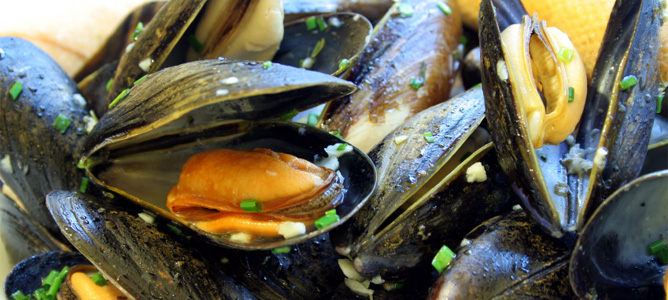
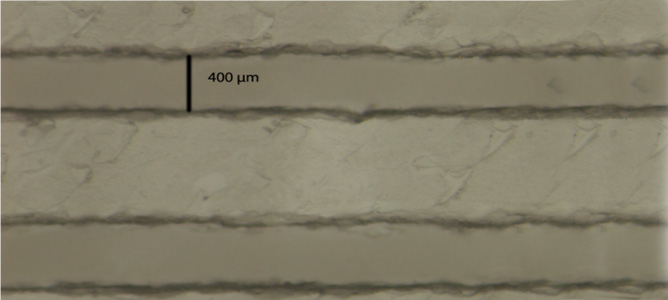
1: 3-dimensional polymer structure for research in mussel farming
February 2012
Utilising the Objet 3D printer for rapid prototyping, researchers at MCN in a collaboration with CSIRO and James Cook University, designed a 3D polymer structure to improve mussel spat capture and enhance the settlement of larvae to ultimately improve the profitability of Victorian mussel farms.
The project aimed to fabricate surface textures that enhance the settlement of mussel larvae, to improve capture of wild mussel spat and therefore profitability. Dr. Andrew Poole from CSIRO and Professor Rocky de Nys from James Cook University utilised the Eden 260V 3-dimensional printing system at MCN to create a fast, clean and accurate prototype of a polymer micro-structured surface. This flexibility in the rapid protoyping cycle allowed the collaborators to immediately change the texture design and produce new polymer surfaces to suit their research requirements. The image above depicts an image of the 400μm groove with 800μm spacing polymer structure that was produced on the 3-dimensional printing system. These surfaces are currently being used for trials at Queenscliff Mussel Hatchery (Department of Primary Industries).


